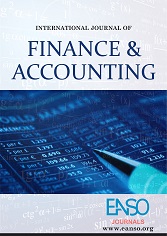Effects of Capital Adequacy on the Financial Performance of Listed Commercial Banks at the Nairobi Security Exchange, Kenya
Abstract
The study's main focus was on the effects of capital adequacy on the financial performance of listed commercial banks at the Nairobi Security Exchange, Kenya. The study was based on signalling theory. A descriptive research design was employed. The study targeted 11 commercial banks listed at the Nairobi security exchange, where the census sampling technique was adopted. Secondary data was sourced from commercial bank statements and annual reports published in NSE between 2018 and 2022. The study presumed that data obtained from published annual audited reports provided quality data, which addressed the study's validity issue. To enhance reliability, a pilot study was carried out on two commercial banks that were not listed at the Nairobi security exchange, and they were selected randomly. The data was analyzed using descriptive analysis, regression analysis, and correlation analysis, where the significance level was tested at 5%. The findings revealed that capital adequacy had a strong and positive effect on Return on assets, and its p-value was < 0.05. The study recommends that banks should seek to increase their asset to boost their growth and maintain reasonable capital adequacy to absorb losses effectively
Downloads
References
Abreu, M. & Mendes, Abera, A. (2012). Factors Affecting Profitability: An Empirical Study on Ethiopian Banking Industry. Unpublished Master’s Thesis. Addis
Adeusi, S. O., Kolapo, F. T. & Aluko, A. O. (2014). Determinants of Commercial Banks’ Profitability Panel Evidence from Nigeria. International Journal of Economics, Commerce and Management, 2(12), 1-18
Aliyu, S., Yusof, R., & Naiimi, N. (2017). The role of moral transaction mode for sustainability of banking business: A proposed conceptual model for Islamic microfinance banks in Nigeria. International Journal of Social Economics, 44(12), 67-90.
Alkhazaleh, A. M. & Almsafir, M. (2014). Bank Specific Determinants of Profitability in Jordan. Journal of Advanced Social Research, 4(10), 01-20
Arrow, K. J. (1972). Gifts and exchanges. Philosophy & Public Affairs, 1(4), 343–362.
Athanasoglou, P., Brissimis, S., & Delis, M. (2011). Bank-specific, industry-specific and Macroeconomic determinants of bank profitability. Journal of International Financial Markets, Institutions and Money, 18(2), 121--136.
Azizi, M & Sarkani.Y.A (2014). Review financial performance of MELLAT Bank According to CAMEL Model, A journal of multidisciplinary research, 3(1), 32-42
Bini, L., Dainelli, F. & Giunta, F. (2011). Signaling Theory and Voluntary Disclosure to the Financial Market: Evidence from the Profitability Indicator. Published in the Annual Report. Paper presented at the 34th EAA Annual Congress, Rome, 20-22 April 2011
Boukhatem, J., & Moussa, F. B. (2018). The effect of Islamic banks on GDP growth: Some evidence from selected MENA countries. Borsa Istanbul Review, 18(3), 231-247.
Central Bank of Kenya. (2014). Bank Supervision Annual Report 2014. Central Bank of Kenya. https://www.centralbank.go.ke/images/docs/Bank%20Supervision%20Reports/Annual%20Reports/2014BSAnnualReport.pdf
Iskandar, A. S., Che-Yahya, N., & Ab Wahid, Z. (2019). Determinants of Commercial Banks' Profitability in Malaysia. Journal of Entrepreneurship & Business, 7(1).
Kachumbo, E. (2020). Determinants of financial performance of commercial bank Fintechs in Kenya (Doctoral dissertation, Strathmore University).
Mainya, S. (2022). The Determinants of financial performance of commercial banks. Sustainable Economic Development: Pattern and Perspective, 39(8), 23-56
Muzahem, A. (2011). An empirical analysis on the practice and determinants of risk disclosure in an emerging capital market: the case of United Arab Emirates (Doctoral dissertation, University of Portsmouth).
Nalianya, S. N., & Miroga, J. (2020). Determinants of financial performance of commercial banks in Kenya: Case of listed banks on the Nairobi Securities Exchange (NSE). The Strategic Journal of Business & Change Management, 7(3), 880 – 897.
Ojeyinka, T. A., & Akinlo, A. E. (2021). Does bank size affect efficiency? Evidence from commercial banks in Nigeria. Ilorin Journal of Economic Policy, 8(1), 79–100.
Spence, M. (1973). Job market signaling. The Quarterly Journal of Economics, 87(3), 355–374.
Swandewi, N. K. M., & Purnawati, N. K. (2021). Capital adequacy ratio mediates the effect of non-performing loan on returns on assets in public commercial banks. American Journal of Humanities and Social Sciences Research (AJHSSR), 5(1), 651-656.
Yisa, Y. (2021). Internal Determinants of Profitability of Some Selected Deposit Money Banks in Nigeria. BAKOLORI JOURNAL OF GENERAL STUDIES, 12(1), 3392-3411.
Copyright (c) 2025 Aletia E. Sylvia, Jared Okello, PhD, Evans Otieno, PhD

This work is licensed under a Creative Commons Attribution 4.0 International License.




























